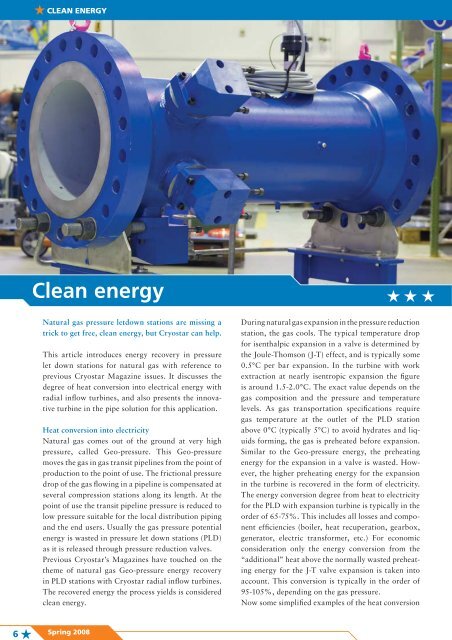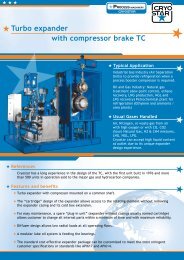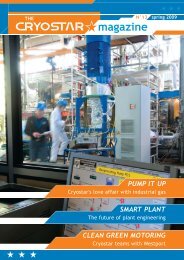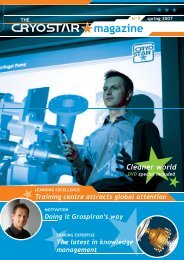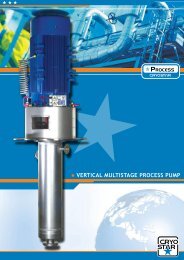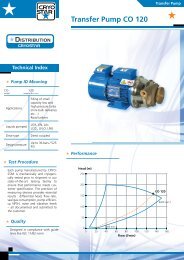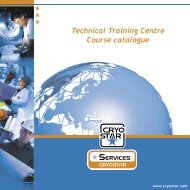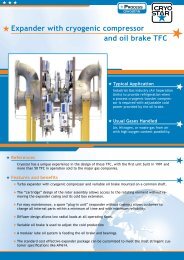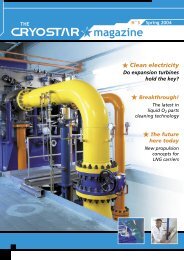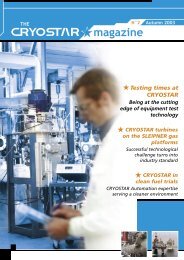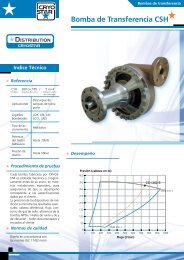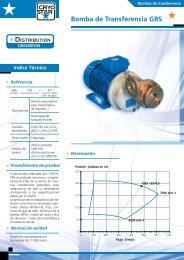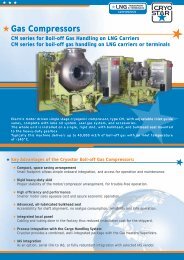hydrocarbons go large clean energy selling success - Cryostar
hydrocarbons go large clean energy selling success - Cryostar
hydrocarbons go large clean energy selling success - Cryostar
You also want an ePaper? Increase the reach of your titles
YUMPU automatically turns print PDFs into web optimized ePapers that Google loves.
CLEAN ENERGYClean <strong>energy</strong>Natural gas pressure letdown stations are missing atrick to get free, <strong>clean</strong> <strong>energy</strong>, but <strong>Cryostar</strong> can help.This article introduces <strong>energy</strong> recovery in pressurelet down stations for natural gas with reference toprevious <strong>Cryostar</strong> Magazine issues. It discusses thedegree of heat conversion into electrical <strong>energy</strong> withradial inflow turbines, and also presents the innovativeturbine in the pipe solution for this application.Heat conversion into electricityNatural gas comes out of the ground at very highpressure, called Geo-pressure. This Geo-pressuremoves the gas in gas transit pipelines from the point ofproduction to the point of use. The frictional pressuredrop of the gas flowing in a pipeline is compensated atseveral compression stations along its length. At thepoint of use the transit pipeline pressure is reduced tolow pressure suitable for the local distribution pipingand the end users. Usually the gas pressure potential<strong>energy</strong> is wasted in pressure let down stations (PLD)as it is released through pressure reduction valves.Previous <strong>Cryostar</strong>’s Magazines have touched on thetheme of natural gas Geo-pressure <strong>energy</strong> recoveryin PLD stations with <strong>Cryostar</strong> radial inflow turbines.The recovered <strong>energy</strong> the process yields is considered<strong>clean</strong> <strong>energy</strong>.During natural gas expansion in the pressure reductionstation, the gas cools. The typical temperature dropfor isenthalpic expansion in a valve is determined bythe Joule-Thomson (J-T) effect, and is typically some0.5°C per bar expansion. In the turbine with workextraction at nearly isentropic expansion the figureis around 1.5-2.0°C. The exact value depends on thegas composition and the pressure and temperaturelevels. As gas transportation specifications requiregas temperature at the outlet of the PLD stationabove 0°C (typically 5°C) to avoid hydrates and liquidsforming, the gas is preheated before expansion.Similar to the Geo-pressure <strong>energy</strong>, the preheating<strong>energy</strong> for the expansion in a valve is wasted. However,the higher preheating <strong>energy</strong> for the expansionin the turbine is recovered in the form of electricity.The <strong>energy</strong> conversion degree from heat to electricityfor the PLD with expansion turbine is typically in theorder of 65-75%. This includes all losses and componentefficiencies (boiler, heat recuperation, gearbox,generator, electric transformer, etc.) For economicconsideration only the <strong>energy</strong> conversion from the“additional” heat above the normally wasted preheating<strong>energy</strong> for the J-T valve expansion is taken intoaccount. This conversion is typically in the order of95-105%, depending on the gas pressure.Now some simplified examples of the heat conversion6Spring 2008


